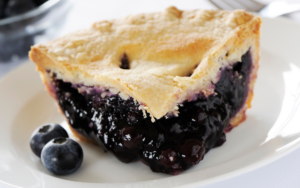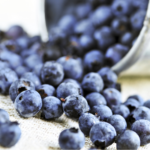Blueberry Pie with Frozen Blueberries: A Guide to Perfecting This Classic Dessert
Blueberry pie is a classic American dessert that embodies the taste of summer. Using frozen blueberries ensures that you can enjoy this treat year-round. Whether for a family gathering or a cozy night in, making a homemade blueberry pie with frozen blueberries is simple and rewarding. Frozen blueberries are not only convenient but also retain a high level of vitamins, making your dessert a bit more nutritious.

Crafting the perfect blueberry pie involves combining a flaky pie crust with a sweet and slightly tart blueberry filling. The science of achieving the right consistency—thick enough to slice but still juicy—is crucial for a pie that holds its shape without sacrificing flavor. While the pie is baking, its aroma can fill a home with anticipation, and the result is a picturesque pie that’s as inviting to look at as it is to eat.
When it comes to serving, a slice of blueberry pie can be enjoyed warm or cold. It can stand alone or be paired with a scoop of vanilla ice cream or a dollop of whipped cream. Storing leftovers properly ensures that every piece of pie tastes as good as the first.
Key Takeaways
- Frozen blueberries make pie-making accessible year-round and are packed with vitamins.
- A balance of a good pie crust and the right filling consistency is key.
- Proper serving and storage enhance the blueberry pie experience.
The Essentials of Blueberry Pie

Creating the perfect blueberry pie involves selecting the right type of blueberries, crafting a flaky pie crust, and employing precise preparation techniques to ensure a delicious outcome every time.
Choosing Your Blueberries
The foundation of any blueberry pie is, unquestionably, the blueberries themselves. While fresh blueberries are often celebrated for their bright flavor, frozen blueberries are a convenient and consistent alternative, offering the flexibility to bake a pie any time of year. It’s important to recognize that frozen blueberries may create additional liquid upon thawing, so adjustments in thickening agents might be necessary. For blueberry enthusiasts eager to understand the complexities of their favorite fruit, further insights can be gleaned from studies on their genetic markers and nutritional quality.
Pie Crust Perfection
A flaky pie crust is the housing for the juicy and flavorful berry filling. Achieving that desirable homemade crust means focusing on a well-balanced dough that’s not overworked, as this will provide the structural integrity and buttery taste every pie lover craves. The central goal is to maintain a cold temperature for the fat, usually butter or shortening, within the dough to ensure a flaky result. I always make sure to chill my dough before rolling it out, which makes a significant difference in the final texture.
Preparation Techniques
When preparing blueberry pie, especially with frozen blueberries, I pay close attention to the thickening of the filling. Since these berries release more juice, I opt for either cornstarch or tapioca to achieve the desired consistency. I start by gently combining the blueberries with sugar, a thickening agent, and a splash of lemon juice to balance the sweetness. Properly cooking the filling on the stove until the berries release their juices is a critical step before assembling the pie. Finally, it’s essential to bake the pie at the right temperature to ensure the crust is golden and the filling is appropriately bubbly.
Assembling Your Blueberry Pie
When I prepare to assemble my blueberry pie, I ensure that the filling is rich and the lattice top is perfectly interwoven to create that classic, appealing look.
Filling the Pie
I start with the blueberry pie filling by mixing frozen blueberries that have been gently thawed with cornstarch, sugar, and a splash of lemon juice to balance the sweetness. It’s important to stir the ingredients gently to avoid breaking the berries while ensuring a uniform mixture.
- Ingredients for the filling:
- Thawed frozen blueberries
- Cornstarch (for thickening)
- Granulated sugar
- Fresh lemon juice
Creating a Lattice Top
Building the lattice top requires attention to detail. I cut even strips of pie dough for my lattice, which I then weave over the filling in an over-and-under pattern. The key is to remain patient and to arrange the strips with care to create that artisanal crisscrossed look.
- Steps to create a lattice top:
- Cut the pie dough into even strips.
- Lay half of the strips across the pie vertically.
- Weave the remaining strips horizontally, lifting alternating vertical strips to create the pattern.
I ensure the lattice strips are properly secured to the edges of the bottom crust, trimming any excess dough. Just before baking, I like to brush the top crust with an egg wash for a golden finish.
Baking Techniques and Tips
When baking blueberry pie using frozen blueberries, I find that precision and certain techniques are critical for a perfect dessert. Below, I’ll go through achieving an ideal bake and how to sidestep common mistakes that can occur during the baking process.
Achieving the Perfect Bake
Preheat Your Oven: Always start with preheating your oven to the recipe’s specified temperature. This ensures a consistent environment for your pie to bake properly.
- Bake on the Middle Rack: To promote even cooking, place your pie on the middle rack of the oven.
- Golden Crust: For that desirable golden-brown crust, bake until the pastry is visibly golden and the filling is bubbling. As referenced in an indirect tip from Baking With Butter, you may need to extend baking time when using frozen berries to ensure a fully cooked crust.
- Cool Completely: Resist the temptation to cut into your pie immediately after baking. Let it cool completely on a wire rack to allow the filling to set.
Avoiding Common Baking Pitfalls
Prevent a Soggy Bottom: Place a baking sheet beneath the pie plate to catch any drips and to provide additional heat at the base of the pie. This can contribute to a crispier bottom crust.
- Foil to Protect Edges: The edges of a pie can burn before the rest of the pie is properly baked. To prevent this, cover the edges of the pie with foil if they begin to darken too much.
- Thicken the Filling: If using frozen blueberries, make sure to include an appropriate thickening agent, like cornstarch or tapioca starch, as suggested by The Baker Chick, to avoid a runny pie filling.
- Bake Until Center Bubbles: It might be tempting to pull the pie out when the edges look done, but make sure the center is bubbling—this indicates the filling has reached the right temperature and will set properly.
By following these targeted techniques and being mindful of common issues, I ensure my blueberry pies are consistently successful.
The Science of Pie Thickeners
In the realm of pie-making, thickeners play a pivotal role, especially when dealing with juicy fruits like blueberries. Cornstarch and tapioca are among the most popular choices due to their ability to absorb excess liquid and prevent a runny pie filling.
Cornstarch is a powerful thickener that, when heated, swells and releases starch molecules into the filling. These molecules intertwine to form a network that traps water and juice, thickening the mixture. I use it because it provides a clear, glossy finish to the filling, making it especially appealing for fruit pies.
In contrast, tapioca, either in flour or pearl form, serves as a reliable thickener that is less likely to break down during the cooking process. When using tapioca, I ensure it has enough time to soften and swell before the pie goes into the oven. Its resilience to freezing makes it a superb choice for pies that will be stored for later use.
Flour, a traditional thickener, is also favored for its accessibility and consistent results. It imparts a slightly cloudy appearance and requires more quantity compared to cornstarch to achieve the same thickening effect. Here’s why I use flour judiciously: it can lend a heavier texture to the filling if overused.
| Thickener | Properties | Why Use It? |
|---|---|---|
| Cornstarch | Clear finish, strong thickening power | For glossy, firm fillings |
| Tapioca | Freezer-friendly, gradual thickening | For a stable structure post-baking and freezing |
| Flour | Readily available, reliable | When a rustic, less glossy texture is desired |
I consider the end texture and how the filling will set once cooled. Will it slice cleanly, or will it pool on the plate? A well-chosen thickener will ensure the filling is enjoyable, both texturally and visually, without altering the delightful taste of blueberries.
Serving and Storage Suggestions

When it comes to blueberry pie, serving it at the right temperature and storing it properly can make all the difference in taste and longevity. I’ll guide you through the optimal methods.
Best Practices for Serving
For a delightful experience, I prefer to serve my blueberry pie at room temperature or slightly warmed. If aiming to impress, accompany each slice with a scoop of vanilla ice cream which complements the pie’s rich flavor. Adding a dollop of whipped cream or a glossy, shiny glaze can also elevate the look and taste. Remember, warmth will unleash the aromas and flavors, making the pie even more irresistible.
Storing Your Blueberry Pie
To maintain freshness, store the pie in an airtight container. This prevents moisture loss and keeps other flavors at bay. If you’re planning to savor the pie over a few days, store it in the refrigerator where it can last up to five days. For a make-ahead treat, blueberry pie can be frozen. Wrap the pie carefully, ensure it’s airtight, and freeze it. When it’s dessert time again, thaw it in the fridge overnight before serving.
Frequently Asked Questions

In this section, I’ll address common concerns and provide clear answers to help you make the perfect blueberry pie with frozen blueberries.
What is the best way to prevent the pie crust from getting soggy when using frozen blueberries?
To prevent a soggy crust, I suggest pre-baking (blind baking) the pie crust before adding the blueberry filling. This creates a barrier that helps to keep the crust crisp. Additionally, using a bit of cornstarch or tapioca starch as a thickener can absorb excess moisture from the blueberries.
How can you adapt a blueberry pie recipe when using frozen blueberries instead of fresh?
When using frozen blueberries, it’s important to account for the extra moisture they’ll release. Increase the thickening agent, such as cornstarch, slightly to compensate. Also, extend the baking time, as the frozen berries will chill the filling, requiring more time to cook through.
What thickener is recommended for a blueberry pie filling made with frozen blueberries?
Cornstarch is a commonly recommended thickener for blueberry pie fillings, as it provides a clear gel and doesn’t interfere with the fruit flavor. Tapioca starch or flour can also be used, which creates a glossy filling that’s appealing in fruit pies.
How do you avoid the filling becoming too watery in a blueberry pie with frozen blueberries?
To keep the filling from becoming too watery, make sure to add an appropriate amount of thickener before baking. Additionally, allow the pie to cool completely before cutting, as this will give the filling time to set and thicken.
Can you make a blueberry pie with a graham cracker crust using frozen blueberries, and if so, how?
Yes, you can use a graham cracker crust for blueberry pie. I would recommend a no-bake filling or cooking the blueberry mixture before pouring it into the crust, as graham cracker crusts tend to be less sturdy and can become soggy if baked with a wet filling.
What are some tips for making a healthy blueberry pie with frozen blueberries?
To make a healthier blueberry pie, opt for a whole wheat pie crust, reduce the sugar by using a sweetener like honey or maple syrup, and increase thickening agents to balance the natural juiciness of the frozen blueberries. Additionally, focus on enhancing the flavor with natural ingredients like lemon zest and spices rather than adding extra sugar.


 Previous Post
Previous Post Next Post
Next Post